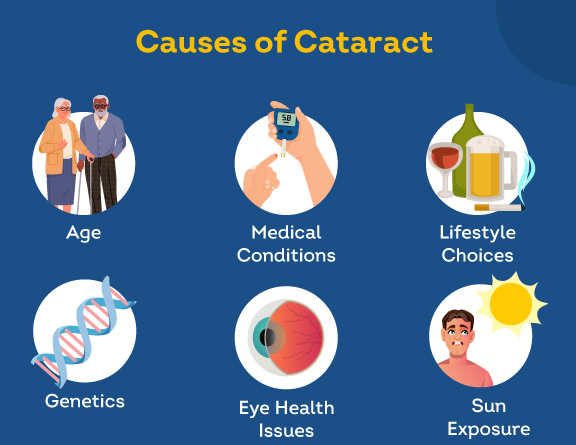
Select City
Black cataract is an advanced and severe form of cataract that can lead to significant vision loss if left untreated. If you experience symptoms like severe vision blurring, difficulty seeing in low light, or increased glare sensitivity, it’s crucial to seek prompt medical attention. Pristyn Care offers expert consultation and advanced surgical treatment for black cataracts, ensuring the best possible care. Book an appointment with an ophthalmologist at Pristyn Care today to explore your treatment options.
Black cataract is an advanced and severe form of cataract that can lead ... Read More




Free Consultation

Free Cab Facility

No-Cost EMI

Support in Insurance Claim

1-day Hospitalization

USFDA-Approved Procedure
Black cataract, also known as hypermature or Morgagnian cataract, is an advanced stage of cataract formation characterised by severe hardening and darkening of the lens nucleus. This condition results from the continued progression of a mature cataract, where the lens becomes overly sclerotic and the nucleus, after undergoing brunescence—a process where the lens colour deepens to yellow and then brown—turns nearly black.
The intense opacification associated with this type of cataract leads to significant visual impairment, often reducing vision to mere light perception or hand movement visibility. This advanced opacification typically happens as a result of prolonged cataract development, which is not addressed timely by surgical intervention.

Fill details to get actual cost
Black cataracts develop primarily due to the ageing process, during which the proteins in the lens of the eye degrade and aggregate, obscuring vision. Here are the specific causes in bullet point form:


These factors can lead to the deterioration of the lens’s clarity, resulting in various stages of cataract formation, eventually culminating in the dense, dark appearance characteristic of black cataracts.
Black cataract, a hypermature form of cataract, can present in a few specific types depending on the progression and characteristics of the condition. Here are the notable types:
These types illustrate the varied progression of black cataracts, emphasising the importance of early detection and management to prevent severe vision impairment.
Black cataracts are associated with several distinctive symptoms that worsen as the condition progresses. Here are the common black cataract symptoms, listed in decreasing order of commonality:
Recognizing these black cataract symptoms early is crucial for timely diagnosis and treatment, preventing further vision loss and improving outcomes through appropriate intervention.
Diet & Lifestyle Consultation
Post-Surgery Follow-Up
Free Cab Facility

24*7 Patient Support
Diagnosing a black cataract involves several steps, each aimed at thoroughly assessing the eye’s condition. Here’s how it is typically evaluated:
The primary black cataract treatment is surgical intervention. Due to the advanced nature of this condition, non-surgical options are usually ineffective. Here’s how it can be treated:
While all cataracts can affect vision, black cataracts are particularly concerning due to their advanced stage and associated complications. Here are the situations when this condition is considered serious:
Addressing black cataracts as soon as these serious signs emerge is critical to prevent irreversible vision loss and other complications.
While black cataracts cannot be entirely prevented, certain measures can significantly reduce the risk or slow down the progression of cataracts in general. These preventive actions focus on maintaining overall eye health and minimising exposure to known risk factors.
While these measures can help lower the risk, it is essential to consult an ophthalmologist regularly, particularly if you notice any changes in your vision.
Understanding black cataracts requires dispelling some common myths. Here are some facts to set the record straight:
Myth: Black cataracts only affect the elderly.
Fact: While more common in older adults, black cataracts can also develop in younger people due to factors like trauma, diabetes, or prolonged UV exposure.
It is important to consult a doctor if you notice significant changes in your vision, such as increased blurriness, difficulty seeing in low light, or heightened sensitivity to glare. These could be early signs of a cataract progressing to a more advanced stage, such as a black cataract.
An ophthalmologist, a specialist in eye conditions, is the best type of doctor to consult. They can perform a detailed examination and provide the appropriate treatment. Visiting a specialist is crucial because black cataracts require precise surgical intervention to prevent further vision loss and manage complications effectively.
These questions will help you have a more informed discussion with your doctor about managing and treating black cataracts effectively.
A regular cataract typically causes a cloudy or opaque lens, while a black cataract represents an advanced stage where the lens has hardened and darkened significantly, leading to severe vision impairment.
Yes, while black cataracts usually develop over time, certain factors like trauma or uncontrolled diabetes can cause rapid progression, leading to sudden and significant vision loss.
No, black cataracts cannot be reversed without surgery. Non-surgical treatments, such as eye drops or lifestyle changes, are ineffective once the cataract reaches this advanced stage.
Delaying black cataract treatment increases the risk of complications during surgery, such as lens rupture, and can lead to permanent vision loss if left untreated.
Yes, black cataract surgery is more complex due to the hardened lens. It requires more advanced surgical techniques and poses a higher risk of complications compared to regular cataract surgery.
While it is possible, black cataracts typically do not develop simultaneously in both eyes. Each eye may progress at a different rate, leading to varying levels of impairment.
Recovery time after black cataract surgery is similar to regular cataract surgery, generally taking a few weeks. However, post-operative care is critical due to the complexity of the condition.
Maintaining a healthy lifestyle, including managing diabetes, avoiding smoking, and protecting eyes from UV exposure, can help slow the progression but will not prevent the development of black cataracts.
Black cataracts themselves do not typically cause pain. However, if associated with other conditions like glaucoma, there may be discomfort or pressure in the eye.
For those at risk, particularly older adults or individuals with diabetes, annual eye exams are recommended to monitor for cataract development and other eye conditions.